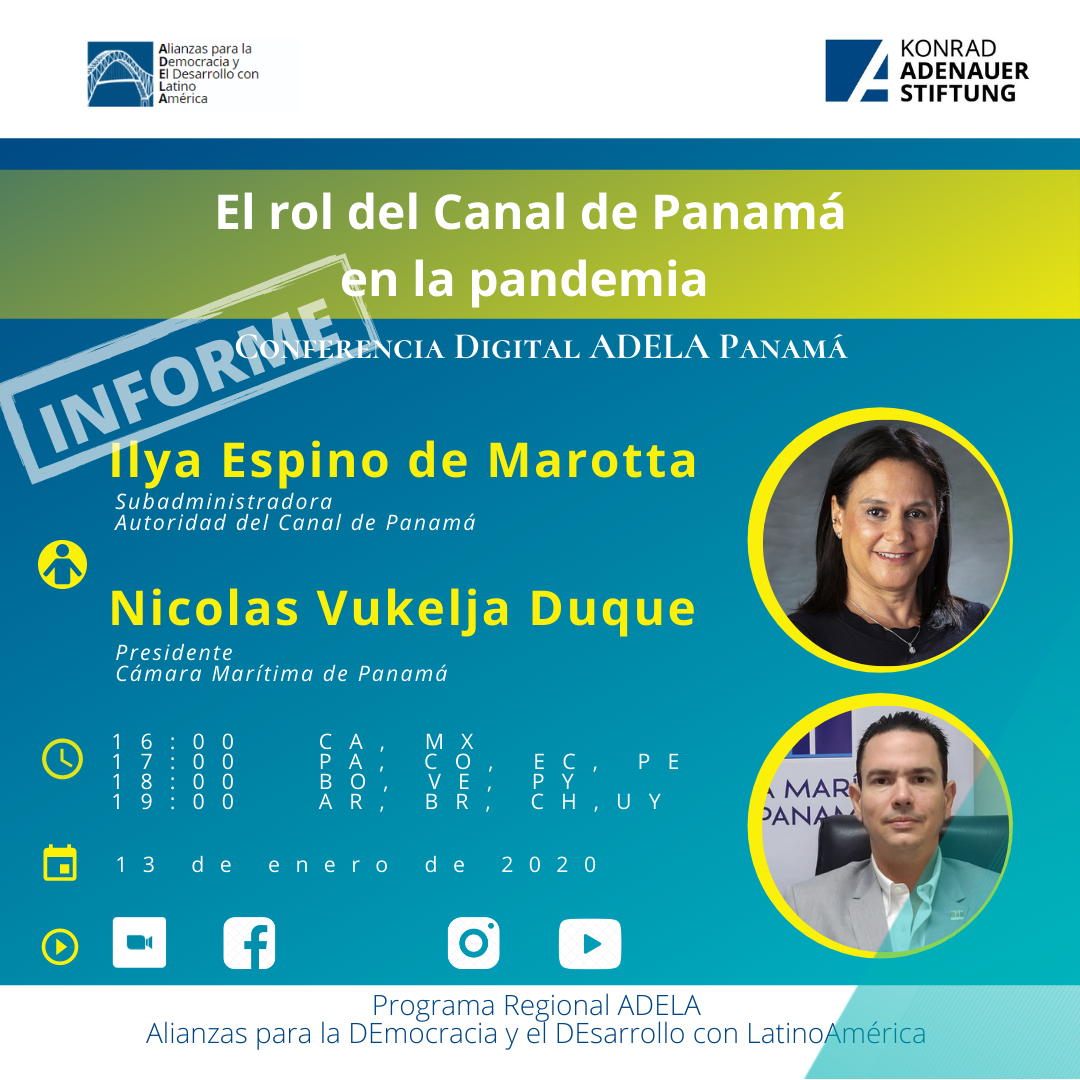The role of the Panama Canal in the pandemic
Speakers
The ADELA regional programme had the pleasure of discussing the role of the Panama Canal in the current pandemic situation on 13 January, with the participation of the Deputy Administrator and Panama Canal Authority, Ilia Espino de Marotta, together with the President of the Panama Maritime Chamber, Nicolás Vukelja Duque.
Event
To put the situation in perspective, following the Panama Canal expansion project, the Canal now handles about thirteen thousand transits per year, representing 252 million long tons per year. The countries that make most use of the canal are the USA, China, Japan, Chile, South Korea, Mexico, Colombia and Peru. The Panama Canal competes with other routes such as the American East Coast-Asia route, the Suez Canal or the Good Hope Canal.
In addition to the current sanitary risk situation caused by Covid-19, the Canal faces other interconnected challenges, like the implementation of technological advances needed to remain a competitive logistics option or the water level.
Regarding the impact of Covid-19 on the flow of vessels through the Canal, the 2021 fiscal year, which starts in October, has recovered from 2020 levels but without reaching the levels of 2019. Some of the most impacted segments were container ships, vehicle carriers, grain and liquefied natural gas. The months of March to July reflect the largest impact, with the number of vessels per day falling from 34-36 to 24-28 during these months. The containership segment is the strongest in the channel, along with bulk carriers, vehicle carriers and fossil fuels such as oil and liquefied natural gas. We must highlight the cancellation of the flow of cruise ships due to the pandemic.
The first actions following the onset of the pandemic were to lay off more than half of the Canal's workforce, around 10,000 workers in total, while the relevant procedures were put in place. However, 4,000 workers continued to work as the Canal's activity was not completely interrupted at any time. From June onwards, however, 100% of workers returned to work in person. Humanitarian actions have been carried out on ships that have been an exception to the Canal's strict regulations, resulting in successes in allowing these people to reach their port.
The main challenge currently facing the Canal is the water level. Due to changes in weather patterns marked by a decrease in precipitation levels in recent years, as well as the advent of more frequent extreme events, levels are lower than in previous years. As a result, water conservation and reuse efforts are being carried out. Also noteworthy is the increase in the country's population, which means an increase in demand. The water level is of vital importance as it influences the draught that the Canal offers to ships. This year has started with a fairly high water level in the longitude, and it is expected to maintain a more competitive draught. For this purpose, weekly or bi-weekly measurements are taken.
As a result of this problem, a tender was published in September last year to undertake a project to provide a complete solution to this problem of lower than desired water levels. This project is currently in the pre-qualification phase, following international industry standards. It is expected that by January next year the contractor for the winning proposal will be appointed. The entire tender process is available online, as it is a transparent process.
The Canal already had very strict protocols in place prior to the pandemic, additional ones have been added. For example, any vessel passing through the Canal must notify the Ministry of Health, as well as any positive Covid-19 cases. In addition, workers' temperatures are measured and random serological tests are carried out among the Canal offices. There is an agreement with the Ministry of Health to link Canal medical staff with Ministry staff. This has allowed a greater control and traceability, although the incidence follows the state trend, i.e. they are increasing in relation to the general situation in the country.
A major advance has been the implementation of automatisation in the registry, which avoids direct contact and speeds up processes. In addition, work is being done to provide added value to ships that choose the Canal, such as repairs or refuelling. This is why we can affirm that the pandemic has driven the implementation of advances in technology. A point for improvement at present is for the customs authorities to work 24 hours a day in synchronisation with the Panama Canal activity to make it a competitive option compared to its other rivals, such as the port of Cartagena, the Caribbean or Jamaica.
The Canal has played a key role in the logistics of medical supplies. As for the distribution of vaccines, there is a willingness on the part of the Canal, although a concrete distribution agreement has not yet been reached. However, there is certainty that the Canal is the most suitable option due to its connectivity and its unbeatable geographical location.
About this series
The Konrad-Adenauer-Stiftung, its educational institutions, centres and foreign offices, offer several thousand events on various subjects each year. We provide up to date and exclusive reports on selected conferences, events and symposia at www.kas.de. In addition to a summary of the contents, you can also find additional material such as pictures, speeches, videos or audio clips.



